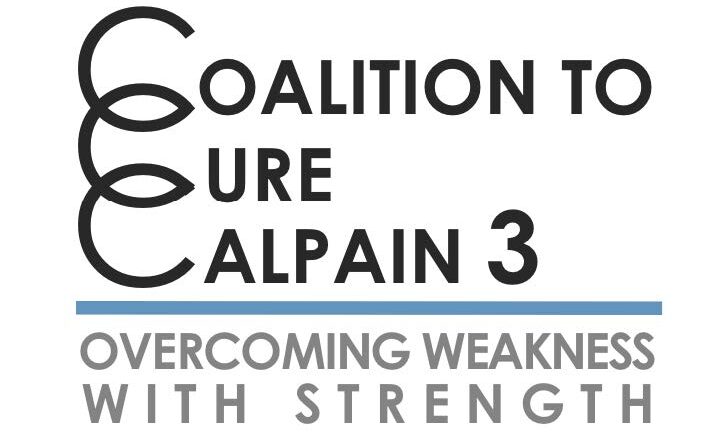FAQs
LGMD2A/Calpainopathy Registry
Thank you for your interest in the LGMD2A/Calpainopathy Registry. Please see below some frequently asked questions. If you have additional questions that are not listed, please read the full FAQ document or contact us at Registry@CureCalpain3.org.
1. Who is Coalition to Cure Calpain 3?
Coalition to Cure Calpain 3 (C3) was founded in October 2010 as a 501(c)(3) non-profit organization to fulfill a mission to drive high potential research and clinical trials while educating the global community about this muscle-wasting disease. C3 has a pinpoint focus to drive research and ultimately a cure for limb-girdle muscular dystrophy type 2A (LGMD2A/R1), a form of calpainopathy. Learn more about C3 at https://www.curecalpain3.org.
2. Who is a Study Participant?
A Study Participant is the individual about whom information is entered into the registry. In the case of an independent person of legal age, this individual will consent for and enter information about themself. If an individual is not of legal age or is an adult who requires someone to act on their behalf, a person (Caregiver/LAR, see below) who is legally responsible for their health care will provide consent and enter information about the Study Participant.
3. What is a Legally Authorized Representative (LAR)?
An LAR is someone who is authorized under applicable law to consent and enter data in the registry on behalf of another individual. The LAR may be a parent, grandparent, spouse, caregiver, or guardian as long as they have the legal authority to grant consent on behalf of that individual. An LAR will sign up on the IAMRARE platform with a Caregiver account. When an LAR acts on behalf of a study participant, they are considered to be the reporter in the research.
4. After consenting, can a Participant choose to stop participating in the study?
Participants are able to withdraw from the study at any time. However, researchers may still use the information that they have collected prior to the participant changing their mind. Information that has already been shared with the RDCA-DAP or other researchers prior to withdrawal cannot be retrieved or removed.
5. What is an Institutional Review Board (IRB)?
An IRB is a board formally designated by an institution or investigator to review, approve the initiation of, and conduct periodic reviews of research involving people. The primary purpose of such an assessment is to assure the protection of the rights and welfare of the participants in the study. This is also known as an Ethics Committee (EC) or Research Ethics Board (REB in Canada).
6. Who can join the study?
This study is open to anyone who has a diagnosis of limb-girdle muscular dystrophy type 2A (also known as LGMD2A, LGMDR1 calpain 3-related, and Calpainopathy) or limb-girdle muscular dystrophy type 1I (also known as LGMD1I or LGMDD4 calpain 3-related) and meets the study inclusion criteria for participation.
7. Is there a cost to participate?
There is no cost to the patient to join this study.
8. How long will this study last?
A registry on the IAMRARE platform will typically be open for at least five years. Participants will be asked to return to the registry periodically to update their information. There is no anticipated date of termination or closure at this time.
9. Can data be collected worldwide?
The registry uses an online platform which allows participants to contribute data from anywhere in the world. Individuals from other countries who enter data into the registry should be aware that data and privacy laws are different in the U.S. than in other countries. This U.S.- based registry will protect data and privacy according to U.S. requirements.
10. What is a Registry Advisory Board?
A Registry Advisory Board is a committee that may include scientists, doctors, and patient advocates. They oversee the conduct of people and organizations involved in the study. The board advises on the development of surveys and reviews combined registry data and the use of this registry. They will ensure proper evaluation of all research requests for use of the registry data. They will also review any protocol or confidentiality deviations and ensure that any such deviations are reported to the IRB.
